Asexual Reproduction In Plants Diagram
Sexual and Asexual Reproduction in Plants – Asexual Reproduction: Vegetative Propagation, Budding, Spores – Sexual Reproduction: Unisexual, Bisexual.
Source | Credits | Moving picture Credits: NCERT Full general Science
Modes Of Reproduction in Plants
- There are several means past which plants produce their offspring. These are categorised into ii types: (i) asexual, and (ii) sexual
- In asexual reproduction plants can requite rise to new plants without seeds, whereas in sexual reproduction, new plants are obtained from seeds.
Asexual Reproduction in Plants
Asexual reproduction occurs through:
- Vegetative Propagation,
- Budding,
- Fragmentation and
- Spore germination.
Vegetative Propagation
- Most plants have roots, stems and leaves. These are called the vegetative parts of a plant.
- Vegetative Propagation is a type of asexual reproduction in which new plants are produced from roots, stems, leaves and buds. Since reproduction is through the vegetative parts of the plant, it is known as vegetative propagation.
- Bryophyllum (sprout leafage plant) has buds in the margins of leaves. If a leafage of this plant falls on a moist soil, each bud tin give rising to a new found.

Bryophyllum (sprout leafage constitute)
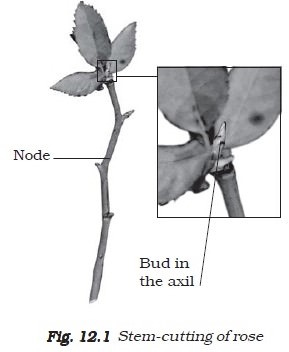
- The roots of some plants can too requite rise to new plants. Sweet potato and dahlia are examples.
- Plants such every bit cacti produce new plants when their parts get detached from the master establish torso. Each detached part tin grow into a new constitute.
- Plants produced past vegetative propagation take less time to abound and bear flowers and fruits earlier than those produced from seeds.
- The new plants are exact copies of the parent constitute, every bit they are produced from a single parent.
Budding
- Yeast is a single-celled organism. The pocket-size bulb-like projection coming out from the yeast jail cell is called a bud.
- The bud gradually grows and gets detached from the parent cell and forms a new yeast jail cell.
- The new yeast cell grows, matures and produces more yeast cells. If this process continues, a large number of yeast cells are produced in a short time.
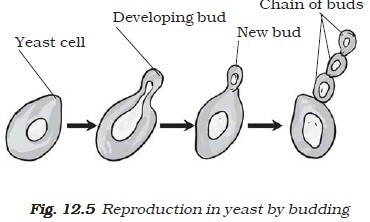
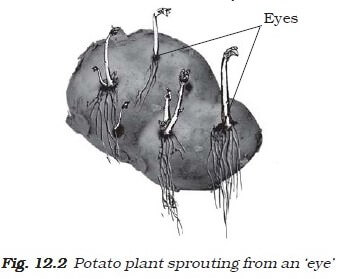
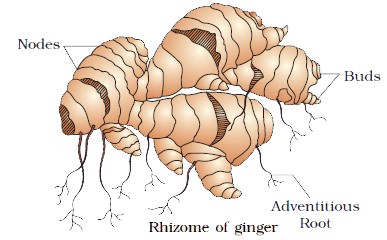
Fragmentation
- When water and nutrients are bachelor algae abound and multiply rapidly past fragmentation.
- An alga breaks upwardly into two or more fragments. These fragments or pieces grow into new individuals. This process continues and they encompass a large area in a short menstruum of time.
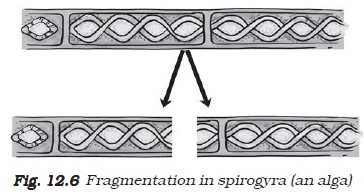
Spore formation
- Fungi on a bread piece grow from spores which are present in the air. When spores are released they keep floating in the air.
- The spores are asexual reproductive bodies. As they are very light, they tin embrace long distances.
- Each spore is covered by a hard protective coat to withstand unfavorable conditions such as high temperature and low humidity. So they can survive for a long time.
- Nether favourable conditions, a spore germinates and develops into a new private.
- Plants such as moss and ferns also reproduce by means of spores.

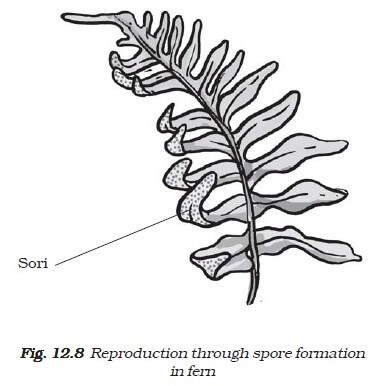
Match the Following
| Cavalcade I | Column Two |
| 1. Bud 2. Eyes 3. Fragmentation 4. Wings 5. Spores | a) Maple b) Spirogyra c) Yeast d) Bread mould eastward) Potato f) Rose |
Sexual Reproduction in Plants – Unisexual and Bisexual
- The flowers are the reproductive parts of a plant. The stamens are the male reproductive role and the pistil is the female person reproductive office.
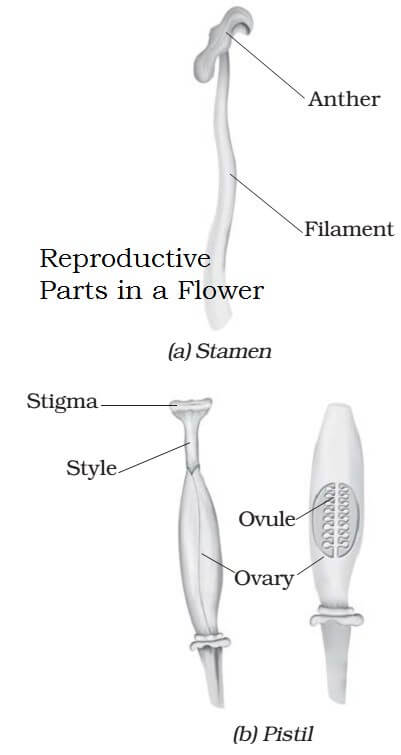
- The flowers which contain either but the pistil or but the stamens are called unisexual flowers. The flowers which comprise both stamens and pistil are called bisexual flowers.
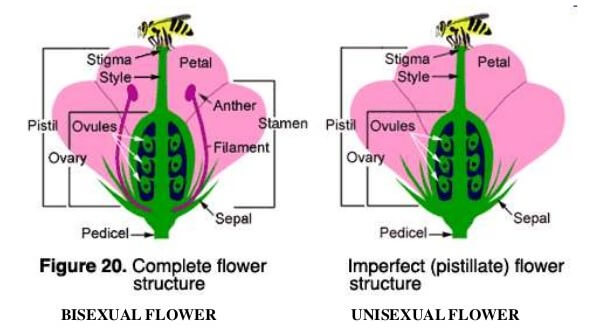
- Corn, papaya and cucumber produce unisexual flowers, whereas mustard, rose and petunia have bisexual flowers.
- Both the male and the female unisexual flowers may be present in the same establish or in unlike plants.
- Anther contains pollen grains which produce male gametes. A pistil consists of stigma, style and ovary. The ovary contains one or more ovules. The female gamete or the egg is formed in an ovule. In sexual reproduction a male and a female person gamete fuse to form a zygote.
Pollination
- Generally pollen grains have a tough protective coat which prevents them from drying up. Since pollen grains are calorie-free, they can be carried by current of air or water. Insects visit flowers and carry abroad pollen on their bodies.
- Some of the pollen lands on the stigma of a blossom of the same kind. The transfer of pollen from the anther to the stigma of a blossom is called pollination.
- If the pollen lands on the stigma of the same flower it is called self-pollination. When the pollen of a blossom lands on the stigma of some other flower of the same found, or that of a dissimilar institute of the same kind, it is called cross-pollination.
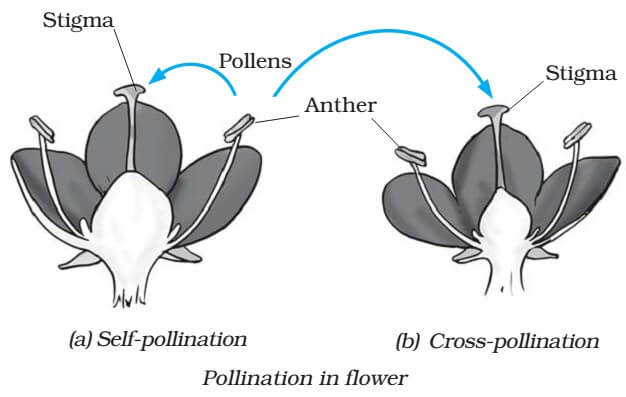
Cocky Pollination vs. Cantankerous Pollination
Self-Pollination | Cross-Pollination |
| one. Pollen grains are transferred to the stigma of the same blossom. 2. Occurs in bisexual plants having anther and stigma maturing at same time. three. Information technology takes place in plants like wheat, peas etc. | 1. Pollen grains are carried to stigma of another flower. 2. Occurs in bisexual flowers having anther and stigma maturing at unlike times. 3. It takes place in plants similar lady- finger, tomato, brinjal etc. |
Fertilisation
- The cell which results after fusion of the gametes is chosen a zygote. The process of fusion of male person and female gametes (to form a zygote) is called fertilization. The zygote develops into an embryo.
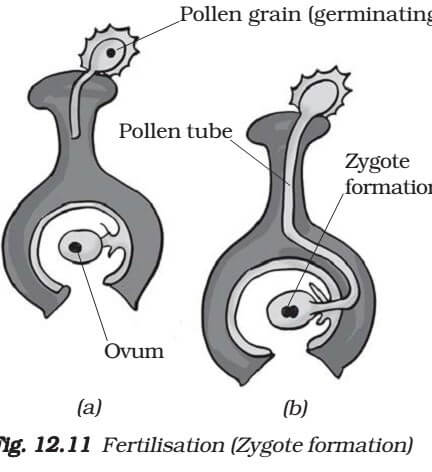
Fruits and seed formation
- After fertilization, the ovary grows into a fruit and other parts of the flower autumn off. The fruit is the ripened ovary.
- The seeds develop from the ovules. The seed contains an embryo enclosed in a protective seed glaze. Some fruits are fleshy and juicy such as mango, apple and orange. Some fruits are hard similar almonds and walnuts.
Seed dispersal
- Some seeds are dispersed by animals, particularly spiny seeds with hooks which go attached to the bodies of animals and are carried to distant places. Examples are Xanthium and Urena.
- Some seeds are dispersed when the fruits burst with sudden jerks. The seeds are scattered far from the parent plant. This happens in the example of Castor and Balsam.
Asexual reproduction vs Sexual reproduction
Asexual reproduction | Sexual reproduction |
| a) Only one parent plant is involved. | a) Both male and female person parents are involved. |
| b) Occurs in unisexual plants. | b) Occurs in bisexual plants. |
| c) Occurs in lower plants. | c) Occurs in higher plants. |
| d) Reproductive organs are not present. | d) Fully developed reproductive parts are present |
| due east) In most of the methods the original parent disappears. | east) Original parents remain alive afterwards process of reproduction. |
| f) Process similar gamete formation or fertilization is not seen. | f) Fertilization of gametes give rises to zygote. |
| g) Characteristics of just one parent is inherited. | g) Characteristics of both parents are inherited. |
| h) No need of seeds. | h) Seeds are used to get new plants from a flower. |
Asexual Reproduction In Plants Diagram,
Source: https://www.pmfias.com/sexual-asexual-reproduction-plants/
Posted by: rosenbergequed1960.blogspot.com


0 Response to "Asexual Reproduction In Plants Diagram"
Post a Comment